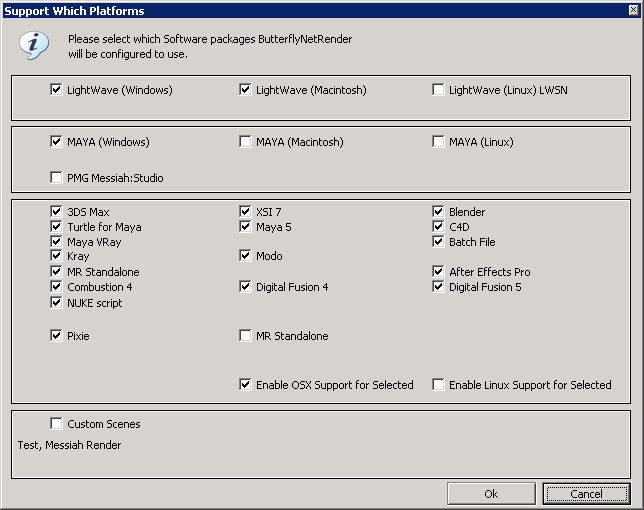After Effects
The overall process of setting up After Effect with ButterflyNetRender is very straight forward:
Contents
Install:
(Windows):
- 1. Install After Effects locally on all the Windows Rendernode machines (in the same location on all machines)
IE: C:\Program Files (x86)\Adobe\Adobe After Effects CS
- 2. Set the Install paths in the BNR Controller
(OSX):
- 1. Install After Effects locally on the OSX Rendernode machines.
- 2. In the BNR OSX Client - set the install path location (The OSX Clients store the platforms paths - where the Windows Controller stores only the Windows Platform paths)
- 3. Setup the POSIX path matching in the Windows Controller (see POSIX path matching section)
Configure:
Configure paths and settings in BNR Controller:
In the BNR Controller:
- 1. Turn on the 'After Effects' platform: (Options->Configure Platforms)
- 2. Set the location of the ae render (the local path on each Rendernode) (Options->Configure Platforms - After Effects)
- 3. Confirm you have the correct command line settings:
(download the updated 'File:Rendertype15.cfg' file and place into the BNR install folder - replacing the current one - Make sure the Controller is not running when you replace the file)
- the command line settings should be: (Options->Configure Platforms After Effects - Settings button - Command Tab)
"%exe%" -project "%loadscn%" -s %sf% -e %ef% -output %prefix%[####].%extnam% -reuse -comp "%v1%" %addlog%
- 4. If running OSX Rendernode - you will need to setup the POSIX path matchine (Options->Configure Directories - OSX POSIX Path Matching)
This is used to match the Windows and OSX paths
- CS6 - License info - setup render only nodes:
Just make sure you follow it verbatim (make sure the name of the text file is "ae_render_node_only.txt"
Restart:
Restart the BNR Controller.
Add:
Now add AE project (.aep) scene files for rendering:
Make sure you add the scene from the Shared Network folder (that all the rendernodes have access to - otherwise the rendernodes will not be able to load the scene)
After you add the AE project - you will need to:
- 1. Select the Frame range (Output Tab)
- 2. Select the Output Frame format (Output Tab)
- 3. Select the Comp name (Render Tab)
(NOTE: You will need to save the AE Project in After Effect with the Settings set to 'single frame output' (not avi) and select skip existing files or multi-machine sequence) and make sure all the Content is on the Shared Network folder
(These are the settings from CS4): File:Aftereffects multimachine.jpg
Test:
The best way to test a new After Effects setup:
- 1. Make sure After Effects is installed on the controller (in the same location as the RenderNodes)
- 2. Add a aep project into BNR
- 3. Select the 'Render' Tab
- 4. Press the 'Test Render Command" and then press 'Launch Locally'
This will run the same command the Rendernodes will get - but you will get to see more information directly (You will need to check the Task manager to see if its running)
- If all works -Then you will need to check the log file from the command line -log filename.log
-Or -
- Right click on the Scene and a select "Open Scene Trace Log folder" and you should find the ae output text "Render_*.txt" - Please open with notepad to view the text.
(note if you see *.csv files - these are BNR Controller state flows)
